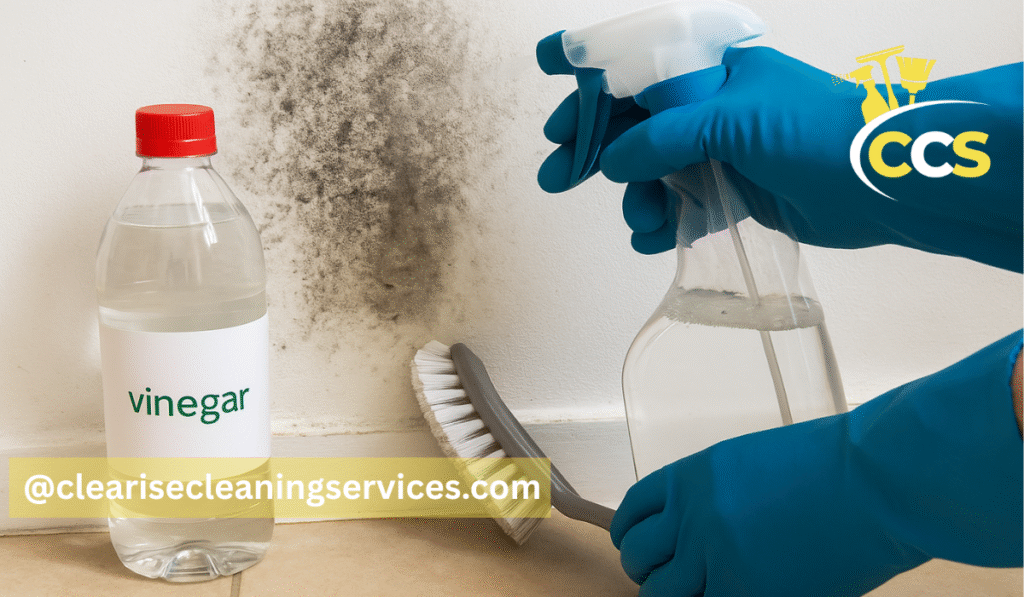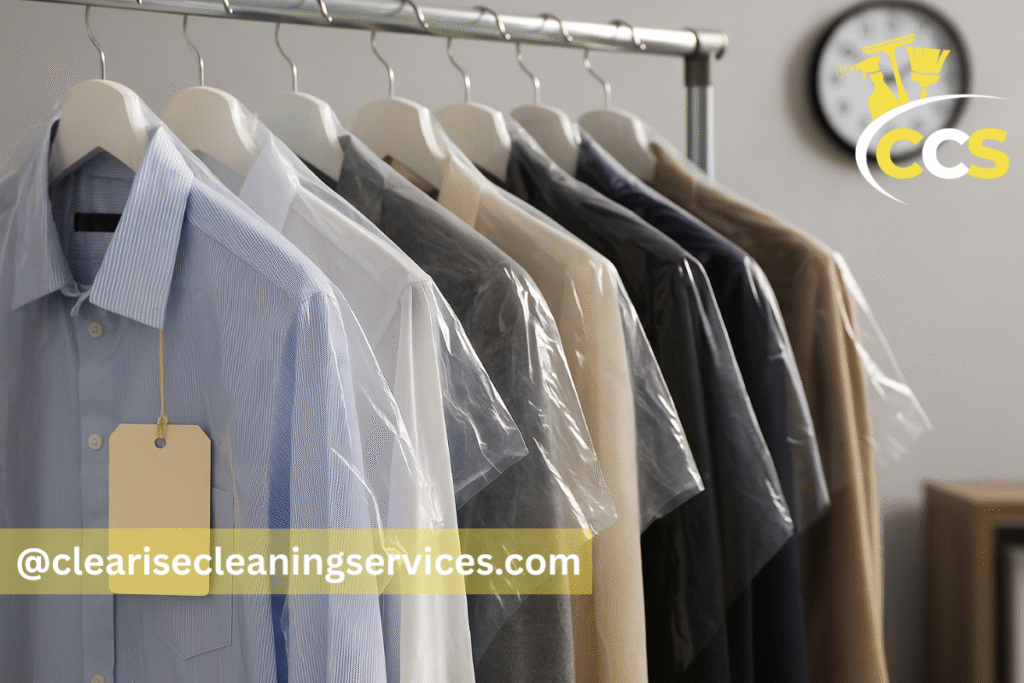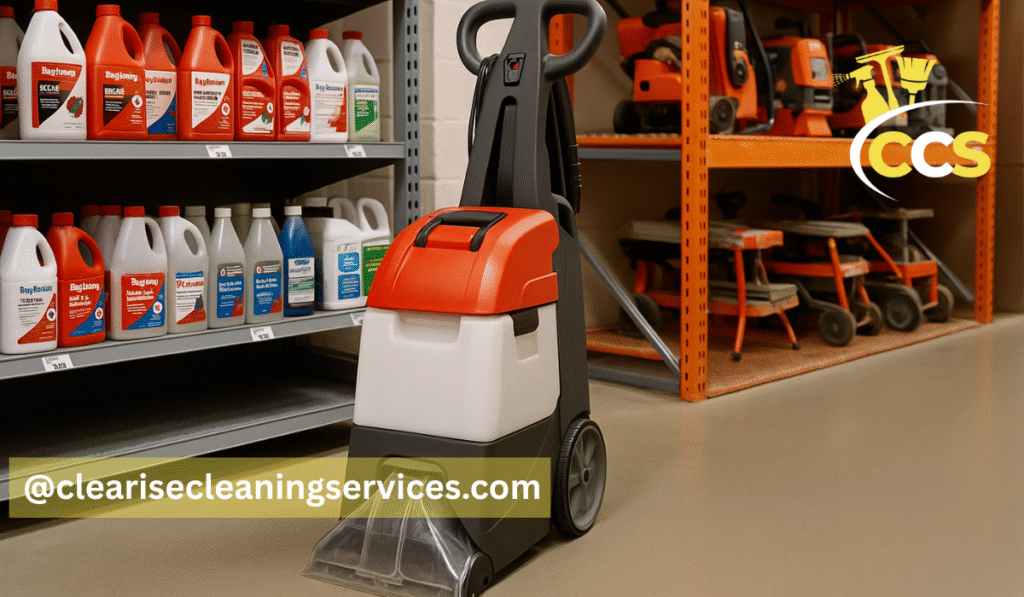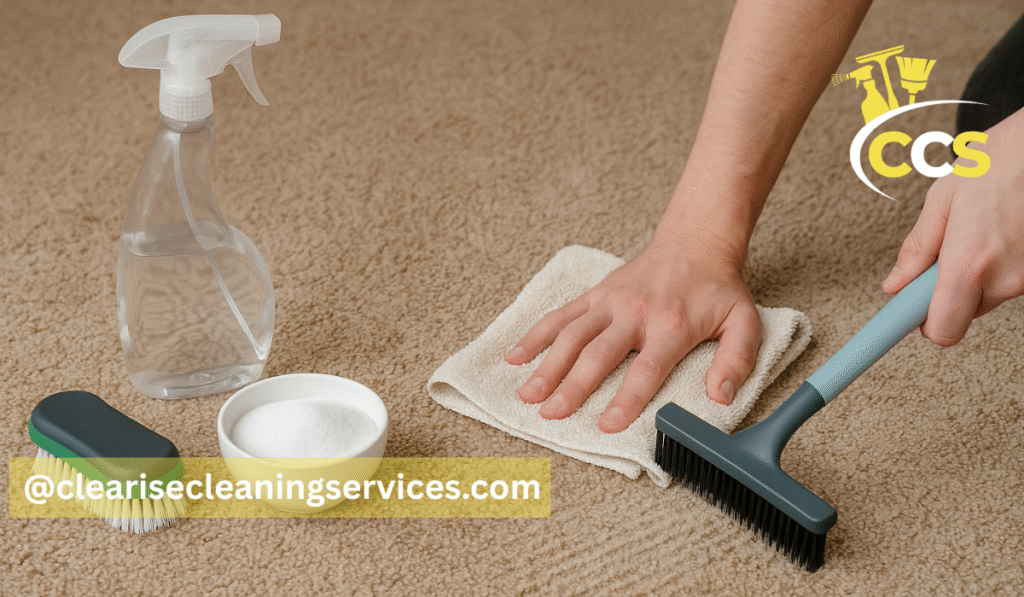When people talk about cleaning mold with vinegar, they’re usually referring to a simple but highly effective home method that uses white vinegar to kill and prevent mold growth on household surfaces. Unlike harsh chemical cleaners, vinegar is non-toxic, affordable, and easy to find — which makes it a go-to choice for many families.
For parents especially, this method matters a lot. Mold exposure can affect the health of babies and young children, often causing breathing issues, allergies, or worsening asthma. At the same time, many chemical cleaners come with strong fumes and risks that aren’t always safe around kids. That’s why vinegar stands out: it offers a safer, natural alternative without sacrificing effectiveness.
In this guide, you’ll learn exactly how and when vinegar works against mold, the right way to use it, and how to stay safe during the process. We’ll walk through step-by-step instructions, share expert-backed tips, cover what to do if vinegar isn’t enough, and explain prevention strategies to keep mold from coming back. By the end, you’ll know how to handle small mold problems at home confidently and safely.
Understanding Mold in the Home: Risks and Realities
What Is Mold — And Why It Grows
Mold is a living fungus made up of microscopic spores that float freely in the air. When these spores land on a damp surface with the right conditions, they begin to multiply. All mold really needs is moisture, warmth, and an organic material to feed on, such as wood, fabric, or drywall.
Inside homes, the most common culprits are species like Penicillium (often found on wallpaper or water-damaged fabrics), Aspergillus (a frequent guest on walls and HVAC systems), everyday mildew (the gray or white spots in bathrooms), and the infamous black mold, Stachybotrys. You’ll usually find mold in bathrooms, behind wallpaper, on windowsills, inside refrigerator gaskets, on ceilings, or tucked away in crawl spaces — basically anywhere that stays damp and lacks airflow.
Health Risks For Infants, Toddlers, And Parents
The real concern with mold isn’t just how it looks; it’s how it impacts health. Mold spores act as allergens. When inhaled, they can trigger respiratory irritation, coughing, sneezing, or asthma attacks. For infants and toddlers, whose immune systems and lungs are still developing, the risks are higher. Parents with asthma, allergies, or compromised immunity are also more sensitive.
Good indoor air quality is especially critical when young children are at home. Even a small mold problem can make the environment uncomfortable or unhealthy. That’s why many parents turn to natural or low-toxicity cleaning options like vinegar — they want to reduce exposure to both mold and harsh chemical cleaners at the same time.
When DIY Cleaning Is Okay — And When To Call A Professional
Not all mold problems are equal. For small, surface-level growth on tile grout, windowsills, or painted walls, DIY cleaning with vinegar is usually safe and effective. But larger or hidden infestations require caution.
The EPA recommends that if mold covers an area larger than about 10 square feet, or if it’s linked to ongoing water damage, it’s best to call in professionals. Warning signs include musty odors that keep coming back, mold that spreads inside HVAC ducts, or signs it has penetrated behind walls or under flooring. In some cases, especially with toxic black mold, legal and safety guidelines even require professional remediation.
Does Vinegar Really Kill Mold? What the Evidence Says
What Vinegar Is — And Why It Can Inhibit Mold
Household white vinegar is more than just a kitchen staple. It’s a mild acid, usually containing about 5% acetic acid in the standard bottles you buy at the store. Some products marketed as “cleaning vinegar” are a little stronger, around 6% acetic acid.
This acidity is what makes vinegar effective against mold. Acetic acid disrupts the structure of fungal cells, slowing or stopping their growth. Beyond that, vinegar has both antimicrobial and antifungal properties, which means it can work against bacteria and fungi at the same time.
Studies and field reports suggest vinegar can kill or at least inhibit a large portion of common household mold species. Depending on the source, estimates go as high as 80% effectiveness. For small mold problems on hard, non-porous surfaces, vinegar is often a reliable first choice.
What Vinegar Doesn’t Always Do — Limits And Caveats
That said, vinegar isn’t a miracle solution. It works best as a first-line cleaner, but it has its limits:
- Slow acting: Vinegar takes time to work. It may need to sit on the surface for an hour or more to make a real difference.
- Doesn’t always reach deep roots: In porous materials like drywall, insulation, or fabric, vinegar can’t always penetrate far enough to destroy the mold’s mycelial roots.
- Not effective against every mold type: Certain species, like Aspergillus fumigatus, show more resistance, and vinegar doesn’t neutralize toxins that some molds produce.
- Surface risks: Used undiluted, vinegar may etch stone countertops, weaken certain wood finishes, or corrode some metals. Even painted surfaces can be damaged if soaked.
- Stain removal is limited: Vinegar kills the mold organism, but the stain or residue it leaves behind often requires scrubbing, baking soda, or an additional cleaner.
Expert Consensus And Best-practice Guidelines
Most green cleaning specialists and indoor-air quality experts agree that vinegar is a safe and effective way to clean small patches of surface mold. Compared to bleach, vinegar carries fewer health risks and penetrates porous surfaces better, making it a smarter option in households with children.
Still, toxicologists and home-health professionals emphasize that vinegar is not a cure-all. If mold doesn’t shrink after treatment, or if it returns quickly, the advice is clear: step up to stronger treatments or hire a professional remediation service. Vinegar is a strong first tool in your cleaning kit, but it shouldn’t be your only line of defense if the problem is serious.
Getting Ready: Safety First and What You’ll Need
Protective Gear And Ventilation
Before you even think about spraying vinegar, it’s important to prepare yourself properly. Mold spores can become airborne during cleaning, and even dead mold particles are enough to trigger allergies or asthma. That’s why protecting your lungs, skin, and eyes should be step one.
The recommended setup includes:
- Gloves: Rubber or nitrile gloves work best to avoid skin contact.
- Eye protection: Safety glasses or goggles keep spores and vinegar out of your eyes.
- Respirator: An N95 mask or better is highly recommended; regular cloth masks won’t stop spores effectively.
- Clothing: Long sleeves and pants that can be washed in hot water, or disposable coveralls if you prefer.
- Footwear: Shoe covers or old shoes that can be cleaned thoroughly afterward.
- Ventilation: Always work in a well-ventilated area — open windows, run exhaust fans, or use a portable fan to move air out of the space.
For parents, there’s extra responsibility. Keep children and pets far away from the work zone, and never clean mold while infants are sleeping in a nearby room. If you’re tackling a larger patch, break the job into smaller zones to avoid overwhelming the air quality in your home.
Tools And Materials Checklist
Having the right tools on hand saves time and keeps the job efficient:
- Spray bottles: Preferably new or clearly labeled so they’re not confused with other cleaners.
- Vinegar: Distilled white vinegar (5% acetic acid) or cleaning vinegar (6%) for stronger action.
- Optional boosters: Baking soda for scrubbing, mild dish soap for residue, essential oils to reduce odor, or hydrogen peroxide/oxygen bleach for stubborn stains (never mix bleach directly with vinegar).
- Scrub tools: Soft and stiff brushes, sponges, cloths, and an old toothbrush for tight corners.
- Disposables: Clean rags, paper towels, and plastic garbage bags for safe disposal of contaminated items.
- Water supply: A bucket of warm water for rinsing surfaces.
- Drying aids: Portable fans or a dehumidifier to pull moisture out of the air.
- Optional: A moisture meter or hygrometer to check humidity levels, which is especially useful for parents trying to prevent mold from coming back.
Preparing The Workspace
The environment you clean in matters almost as much as the cleaning itself. A poorly prepped area can spread spores around the house:
- Isolate the zone: Close doors to the affected area. If spores might spread, hang plastic sheeting as a barrier. Seal off ventilation grilles, and turn off HVAC systems to avoid contaminating ducts.
- Ventilate properly: Open windows and run fans or exhaust systems before, during, and after cleaning to keep vinegar fumes and spores moving outdoors.
- Protect belongings: Remove soft furnishings, rugs, or toys from the area. If they can’t be removed, seal them in heavy plastic bags until the work is complete.
- Check for moisture: Before spraying vinegar, do a quick moisture audit. Identify leaks, dripping pipes, or condensation sources. Shut off water if needed, and dry surfaces with fans or a dehumidifier to bring indoor humidity below 50%.
Getting these steps right not only makes the cleaning safer but also sets you up for better long-term results. Mold thrives on dampness and neglect, so preparation is half the battle.
Step-by-Step: How to Clean Mold with Vinegar
Applying Undiluted Vinegar
When it comes to mold, vinegar works best in its pure form. Standard white vinegar contains about five percent acetic acid, while cleaning vinegar pushes closer to six percent. That small difference gives it more punch, and dilution only weakens its effect. To start, pour undiluted vinegar into a clean spray bottle and label it clearly so there’s no mix-up later.
Spray it directly onto the moldy surface, making sure the area is fully covered. For delicate materials like drywall or unfinished wood, avoid oversoaking since they can absorb too much liquid. Once applied, the vinegar needs time to work—at least half an hour, but an hour or even overnight can make a noticeable difference on stubborn patches.
Agitation And Reinforcement
After the vinegar has had time to sit, scrubbing is what really brings results. Use a soft brush on painted walls to avoid scuffing the surface, and a stiffer brush on grout or tile where mold clings more tightly. For those hard-to-reach corners, a simple toothbrush often does the job. If stains remain after this first pass, baking soda can help. A light baking soda solution adds just enough grit to lift away stubborn residue and leaves the surface smelling fresher.
On more delicate finishes, a drop of dish soap mixed with warm water loosens debris without being too harsh. And if the mold still refuses to budge, a follow-up with hydrogen peroxide or oxygen bleach can help, though you should never mix them directly with vinegar since that combination produces harmful fumes. Once scrubbing is finished, rinse or wipe the surface with warm water, working from the top down so any runoff doesn’t spread spores further.
Drying And Oost-Treatment
Killing mold is only half the job—preventing it from coming back is the other. After cleaning, the area needs to be dried completely because lingering dampness is the perfect environment for mold to return. Open windows, set up fans, or run a dehumidifier until the space feels dry to the touch.
As a final step, you can lightly mist the area with vinegar again and let it air-dry without rinsing. This leaves behind a thin protective layer that helps discourage new growth. Be sure to throw away any rags or sponges you used in sealed bags outdoors, and wash clothing or gloves in hot water if they’re reusable.
Special Care By Surface Type
Not all surfaces respond the same way to vinegar. Drywall and painted walls usually handle it well, but it’s wise to test a small patch first and scrub gently to avoid damage. Wood can be more sensitive, so a diluted solution and quick drying work best to protect the material. In bathrooms, vinegar is especially effective on tile and grout, though you may need baking soda or oxygen bleach to tackle stains that have set in.
Leather, vinyl, and other delicate finishes require a softer approach—diluted vinegar applied with a cloth rather than sprayed directly. Stone surfaces like marble or limestone should generally be avoided since vinegar can etch and dull them, and metals may corrode if left in contact for too long. Fabrics and carpets are the trickiest; vinegar may kill surface spores, but because mold can grow deep into fibers, replacement or professional cleaning is often the only solution.
What To Do If Mold Returns Or Persists
Even with the best efforts, mold sometimes reappears. If that happens, repeat the vinegar treatment and consider extending the contact time. Improving ventilation and keeping humidity below fifty percent can make a big difference in preventing regrowth. Once the surface is clean and dry, applying a mold-resistant sealant or paint can provide longer-term protection.
But if mold continues to return in the same spot, it usually points to a deeper issue like a hidden leak, roof damage, or poor airflow that needs to be fixed. And if the mold covers a larger area—anything beyond about ten square feet—or spreads into HVAC systems or behind walls, that’s when it’s time to call in professional remediation.
Preventing Mold Recurrence: Vinegar and Beyond
Cleaning mold is only part of the solution. If the underlying conditions that allowed it to grow remain the same, you’ll see it return sooner than you’d like. This is why prevention is just as important as the initial cleanup. Vinegar can play a role here, but it works best as part of a broader strategy.
Regular Vinegar-based Maintenance
A simple but effective way to stay ahead of mold is to keep a spray bottle of vinegar handy for regular maintenance. Lightly misting areas that are prone to dampness—such as shower walls, window sills, or fridge seals—once a week can slow mold from settling in again.
In bathrooms, a quick vinegar spray after a shower, followed by running the fan or opening a window, goes a long way in keeping walls and grout clear. Vinegar can even help in your laundry routine. Running an empty hot cycle with a cup of vinegar helps prevent mold buildup inside washing machines, especially in the gasket of front-loading models.
Environmental Controls
Mold doesn’t thrive in dry, well-ventilated environments. Keeping indoor humidity under fifty percent makes your home far less welcoming for spores. A small hygrometer, which measures humidity levels, can give you a clear picture of the air in your home. If you notice humidity creeping up, especially in basements or bathrooms, a dehumidifier is worth the investment.
Proper ventilation also matters. Use exhaust fans when showering or cooking, and keep air moving by opening windows or running ceiling fans when possible. And of course, the most important step is to fix any leaks quickly—whether it’s a dripping pipe, a sweating window frame, or a leaky roof, moisture is the fuel that mold relies on.
Material And Design Choices
In some cases, the materials in your home can either help or hinder mold control. Bathrooms, for example, benefit from mold-resistant drywall or tiles sealed with grout protectant. Kitchens with solid, non-porous surfaces are far easier to keep mold-free than those with unfinished wood or old laminate.
If you’re renovating or replacing materials after water damage, choosing options designed to resist moisture will save you headaches down the line. Even small decisions—like avoiding heavy carpeting in damp basements—can make a noticeable difference.
Lifestyle Habits To Reduce Mold Risk
Day-to-day habits also play a role in prevention. Hanging damp towels, rinsing bath toys, and drying out bath mats can stop mold from having the constant supply of moisture it craves. Avoid pressing furniture tightly against walls where condensation builds up, since trapped air encourages mold growth.
It also helps to do a “moisture check” from time to time—look under sinks, around windows, and behind appliances like refrigerators for any early signs of dampness. Catching these issues early allows you to fix them before mold has a chance to spread.
Expert and Parent-Tips: Improving Effectiveness and Safety
Expert Advice From Indoor-air Quality And Green-cleaning Specialists
Professionals who specialize in air quality and eco-friendly cleaning often recommend starting with undiluted white vinegar for the initial treatment, since this ensures the highest concentration of acetic acid makes contact with the mold. However, they also caution about surface sensitivity. On certain materials, it’s smart to follow up with a gentler rinse or a less acidic solution to protect the finish over time.
Another key piece of expert advice is to never mix vinegar with bleach or hydrogen peroxide. Both combinations create dangerous chemical reactions that release toxic fumes. Instead, each product should be used separately, with the surface thoroughly rinsed between treatments. Finally, experts emphasize patience. Vinegar isn’t a quick-fix chemical—it works best when it’s given time to seep into textured surfaces and tiny cracks, often requiring at least an hour of dwell time to break down mold structures effectively.
Tips From Parents And DIY Cleaners
Parents who deal with mold at home often share practical tricks that make the process safer and more manageable around children. The strong vinegar smell can be overwhelming for kids, so a few drops of essential oils like eucalyptus, lemon, or lavender in the spray bottle can help mask the odor without interfering with effectiveness. Ventilation is also key; keeping windows open or fans running can make the smell less noticeable.
Many parents also prefer cleaning in short sessions of about fifteen minutes, rather than tackling a large job all at once, to reduce exposure to both fumes and spores. In children’s rooms, using disposable gloves and cloths is often the safest choice. Once used, these items should be sealed in a bag immediately and taken outside so spores aren’t tracked through the house. A final smart habit is documenting mold-prone areas with photos and checking them regularly. A quick visual record makes it easy to catch small patches early before they turn into bigger problems.
Uncommon But Helpful Suggestions
Beyond the standard practices, there are a few lesser-known tricks that can help parents and homeowners stay ahead of mold. Moisture absorbers like silica gel packs or desiccant containers can be tucked into closets, toy bins, or under cribs in humid climates to keep these sensitive areas dry. In bathrooms or other spots where mold returns often, some homeowners install a small UV light or ventilated fan inside hidden spaces, such as a ceiling void or behind a shower wall, to control moisture and discourage growth.
Another smart preventive step is using a moisture meter to check drywall or wood after plumbing repairs or during seasonal changes. It’s an early warning system that can reveal dampness before mold becomes visible. And for crawl spaces or basements, spraying vinegar once a year on dry foundation walls creates a low-toxicity barrier that helps keep spores from settling in the first place.
Conclusion
Cleaning mold with vinegar is a low-toxicity, budget-friendly, and effective first-line method that’s particularly appealing for parents who want to avoid exposing their families to harsh chemicals. While vinegar isn’t the fastest or strongest cleaner available, it strikes the right balance between safety and effectiveness, making it a smart choice for small household mold problems.
The key to success lies in using it properly: apply it undiluted, give it time to work, scrub where necessary, and follow up with thorough drying. Pairing vinegar with preventive steps—like lowering humidity, fixing leaks, and performing regular maintenance—will give you the best chance of keeping mold away for good.
Finally, remember that timing matters. Catching mold early makes it easier to manage, while waiting allows it to spread and become a bigger issue. If mold keeps coming back, covers a large area, or moves into hidden places like HVAC systems or behind walls, it’s time to call a professional. With smart, consistent care, vinegar can be one of the simplest and most reliable tools in your home-cleaning arsenal.
Frequently Asked Questions (FAQ)
Can I Mix Vinegar With Bleach Or Bleach-based Cleaners?
No. Vinegar and bleach should never be combined. When mixed, they release toxic chlorine gas, which can be extremely harmful if inhaled. The same goes for vinegar and hydrogen peroxide—together they create peracetic acid, a corrosive substance that irritates skin, eyes, and lungs. Always use these cleaners separately and rinse surfaces well if you switch between products.
Does Vinegar Stain Mold Or Leave A Residue?
Vinegar is very effective at killing mold, but that doesn’t mean stains will disappear instantly. Often, the dead mold and its pigments remain behind. If discoloration lingers, it usually takes a bit of scrubbing with baking soda paste or a mild cleaner to fully remove the residue. Once scrubbed, rinse the surface with warm water to leave it clean and fresh.
What If The Mold Smell Stays Even After Cleaning?
A lingering musty odor usually points to deeper issues. Mold roots, or mycelium, can remain hidden in porous materials like drywall, carpet, or insulation. In some cases, there may be a hidden moisture source feeding the problem. If odors continue after cleaning, focus on drying the space thoroughly, check walls or materials for trapped moisture, and don’t hesitate to call a professional if the smell persists.
Is Bleach Better Or Faster Than Vinegar?
Bleach can kill surface mold quickly, but it doesn’t penetrate porous surfaces such as drywall or wood. That means mold often comes back once the surface dries. Bleach also produces harsh fumes that can irritate the eyes, skin, and lungs, which makes it less suitable for homes with children. Vinegar works more slowly, but it penetrates better, is safer to handle, and usually provides longer-lasting results against regrowth.
Can I Use Vinegar On Baby Toys, Crib Slats, Or Children’s Furniture?
Yes, vinegar is one of the safer options for cleaning items used by children. It’s best to dilute it slightly and test a small spot first to make sure the surface doesn’t react. After cleaning, rinse thoroughly with warm water and allow the items to dry completely before use. And always keep children and pets away from the area during the cleaning process until the space is fully dry and ventilated.
Disclaimer: This content is for informational purposes only and should not replace professional advice. Vinegar may help with small, surface-level mold, but larger or hidden infestations require certified remediation. Always use proper safety precautions when handling mold.
Thanks for visiting Clearise Cleaning Services! Discover more helpful tips and expert cleaning insights by exploring our related categories.




